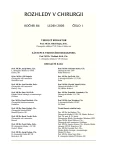Could the Peroperative Manometry of the Oesophagus Be Used for Prediction of Dysphagia Following Antireflux Procedures?
Může být peroperační manometrie jícnu využita v predikci dysfagie po antirefluxním výkonu?
Úskalím laparoskopické antirefluxní chirurgie je možný výskyt pooperační perzistující dysfagie, která snižuje kvalitu života operovaných. Mezi více variantami antirefluxních operací není známa žádná, která by toto riziko zcela eliminovala. Ve studii podporované grantem IGA MZ ČR ND 7142-3 bylo prováděno peroperační měření tonu v oblasti dolního jícnového svěrače (LES) za současné mechanické kalibrace manžety 40 Fr jícnovou sondou. Kompletní manžeta podle Nissena-Rossettiho byla provedena u 39 pacientů. Byl monitorován peroperační nárůst tlaku LES po provedení antirefluxní manžety. Pacienti byli dále sledováni a pozornost byla zaměřena na výskyt dysfagie. U skupiny pacientů s peroperačním nárůstem tonu LES vyšším než 15 mmHg byl zjištěn signifikantně vyšší výskyt prolongované dysfagie. U nízkého peroperačního nárůstu tonu LES byl výskyt dysfagie nízký a současně byla zachována dobrá účinnost pro zábranu patologického gastroezofageálního refluxu. Nebyla zaznamenána žádná komplikace související s peroperační jícnovou manometrií. Délka antirefluxní operace s peroperační manometrií se průměrně prodloužila o 4 minuty. Vyhodnocení dat ukazuje, že antirefluxní efekt fundoplikace není zajištěn jen prostým nárůstem tonu LES a pacienti nemohou mít benefit z jeho extrémně vysokých hodnot. Naopak mohou vysoké hodnoty nárůstu upozornit na riziko dysfagie v pooperačním průběhu.
Klíčová slova:
reflux – fundoplikace – laparoskopie – dysfagie – manometrie
Authors:
V. Procházka
; Z. Kala
; R. Kroupa 1
; P. Kysela; L. Izakovičová Hollá 2; Jiří Dolina 1
Authors‘ workplace:
Chirurgická klinika FN Brno-Bohunice, přednosta prof. MUDr. J. Vomela, CSc.
; III. interní gastroenterologická klinika FN Brno-Bohunice
1; Ústav patologické fyziologie LF MU Brno
2
Published in:
Rozhl. Chir., 2005, roč. 84, č. 1, s. 7-12.
Category:
Monothematic special - Original
Overview
A possible development of the postoperative persisting dysphagia, which decreases the quality of life of the operated, remains the main drawback of the laparoscopic antireflux surgery. Among several variations of the antireflux surgical procedures, there is none known to completely eliminate this risk. In this study, supported by the IGA MZ ČR ND 7142-3 grant, peroperative measurements of the lower oesophageal sphincter (LES) tone with a concurrent mechanical callibration of the cuff using an oesophageal tube were taken. A complete Nissen-Rossetti cuff was applied in 39 patients. Peroperative increases in the LES tone following the completion of the antireflux cuffs were monitored. The patients continued to be monitored with the aim to detect the onset of dysphagia. In the patient group with the peroperative LES tone increase exceeding 15 mmHg, significantly higher rates of prolonged dysphagia were recorded. In cases of lower LES increases, the rates of dysphagia were low and good functioning to prevent any pathological gastrooesophageal reflux was maintained. No complication with respect to the peroperative oesophageal manometry was recorded. Duration of the antireflux operation conducted with the peroperative manometry was prolonged by 4 minutes, on average. Based on the assessment of the data, the authors demonstrate that the LES tone increase on its own, does not provide for the antireflux efect of the fundoplication procedures and that the patients cannot benefit from its extremely high values. On the contrary, its high values may indicate possible risks of dysphagia in the postoperative period.
Key words:
reflux – fundoplication – laparoscopy – dysphagia – manometry
Labels
Surgery Orthopaedics Trauma surgeryArticle was published in
Perspectives in Surgery

2005 Issue 1
- Metamizole vs. Tramadol in Postoperative Analgesia
- Metamizole at a Glance and in Practice – Effective Non-Opioid Analgesic for All Ages
- Metamizole in perioperative treatment in children under 14 years – results of a questionnaire survey from practice
Most read in this issue
- Injuries to the Biliary Tract during Cholecystectomy
- Hemipelvectomy for a Desmoidal Tumor
- Anatomical Resection for Liver Metastases of the Carcinoma of the Large Intestine and the Rectum
- The Cystadenocarcinoma of the Appendix
